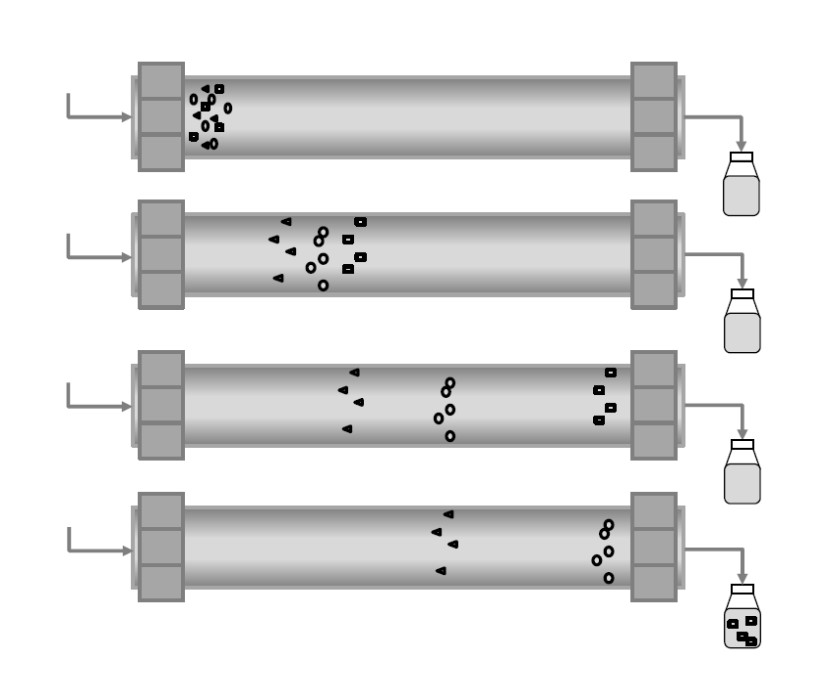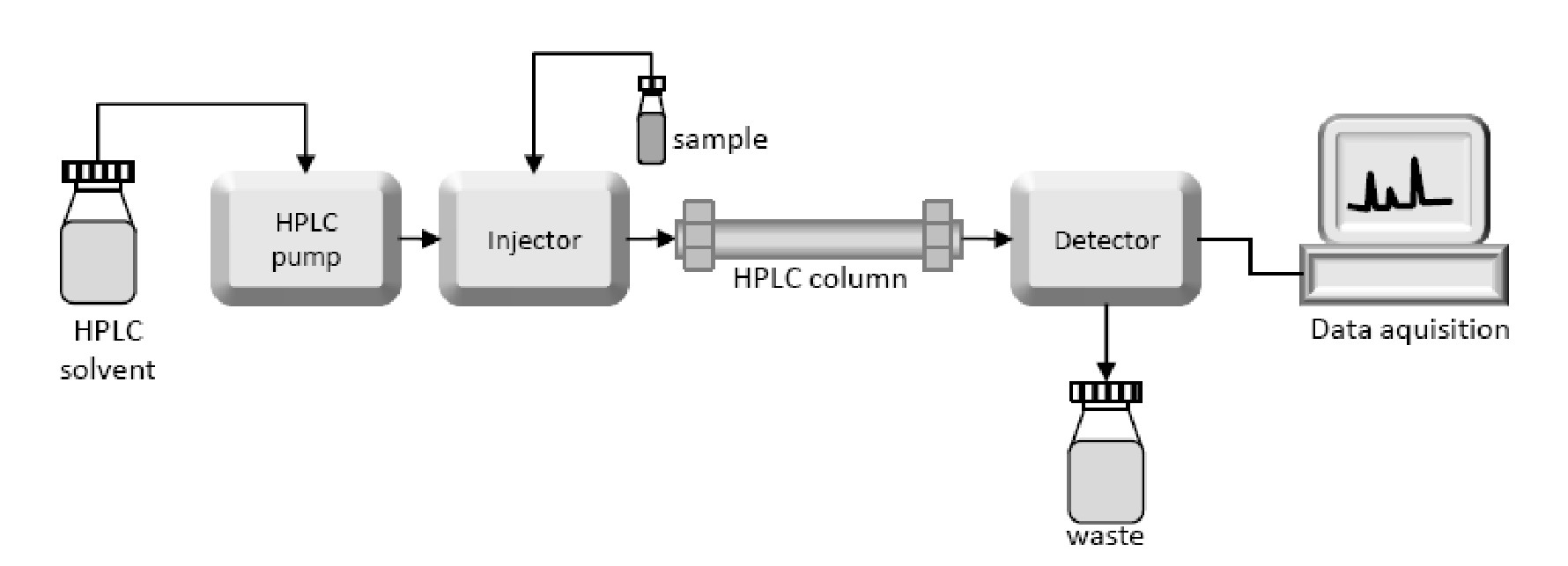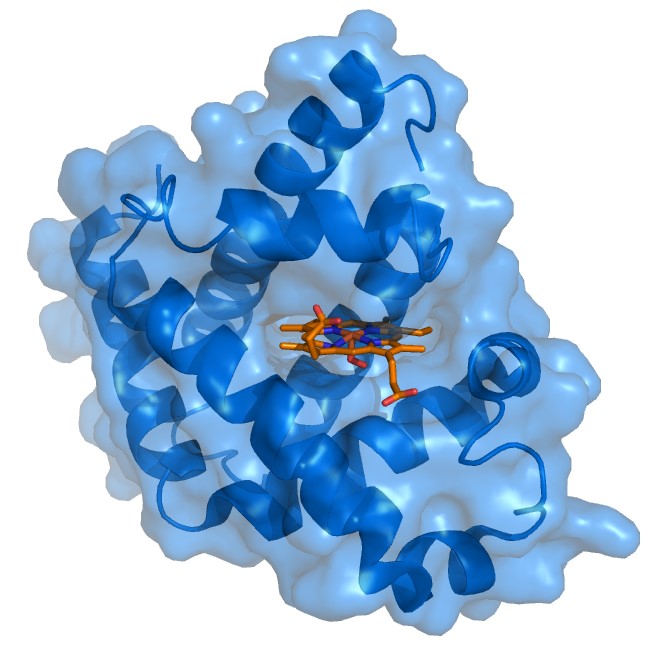High-Performance Liquid Chromatography (HPLC)
High-Performance Liquid Chromatography (HPLC) is a powerful and versatile analytical technique widely used to separate, identify, and quantify components in complex mixtures. It is indispensable in various scientific disciplines, including chemistry, biology, and medicine.
Basic Principles of HPLC
Chromatography is a separation technique based on the differential distribution of components between a stationary phase and a mobile phase. The components of a sample interact differently with these phases, leading to their separation.
HPLC improves upon traditional liquid chromatography by using high pressure to force the mobile phase through a column packed with a finely divided stationary phase. In HPLC, the stationary phase consists of small, uniform particles packed into a column. These particles are typically made of silica or polymeric materials and are coated or functionalized to provide specific interactions with the analytes. The mobile phase is a liquid solvent or solvent mixture that flows through the column. It transports the sample and interacts with the stationary phase. Separation is based on the different interactions of the analytes with the stationary phase and the mobile phase. Analytes that interact more strongly with the stationary phase are retained longer, while those with weaker interactions elute faster. After separation, analytes are detected as they elute from the column. Common detection methods include UV/Vis absorbance, fluorescence, and mass spectrometry.
 Figure 1. Separation of a compound on a chromatographic column (Czaplicki, 2013).
Figure 1. Separation of a compound on a chromatographic column (Czaplicki, 2013).
How Does HPLC Work?
Sample Injection: Samples must be dissolved in a solvent compatible with the mobile phase. Proper sample preparation ensures that the analytes are fully dissolved and free of particulates that could clog the column. The prepared sample is injected into the HPLC system using an autosampler or manual injector. The sample is introduced into the mobile phase stream, which carries it into the column.
Column and Stationary Phase: The HPLC column is packed with a stationary phase material. The choice of stationary phase (e.g. C18, silica or polymeric) depends on the type of separation required. The analytes interact with the stationary phase based on their chemical properties. For example, in reversed-phase HPLC, hydrophobic interactions between the analytes and the nonpolar stationary phase lead to separation.
Mobile Phase and Elution: The mobile phase is pumped at high pressure through the column. The flow rate is typically constant and can be adjusted to optimize separation. As the sample moves through the column, analytes are separated based on their interactions with the stationary phase. More strongly interacting analytes are retained longer and elute later, while less strongly interacting analytes elute earlier.
Detection and Data Analysis: As the analytes leave the column, they are detected by a variety of methods. The choice of detector depends on the properties of the analytes. UV/Vis detectors measure absorbance, fluorescence detectors measure light emission, and mass spectrometers provide detailed molecular information. The detected signals are recorded as chromatograms showing the intensity of the signal versus time. Retention time and peak area or height are used to identify and quantify the analytes.
 Figure 2. Schematic diagram of the HPLC system (Czaplicki, 2013).
Figure 2. Schematic diagram of the HPLC system (Czaplicki, 2013).
Types of HPLC
HPLC systems are classified based on the type of separation they perform and the nature of the stationary and mobile phases. The main types of HPLC include:
Table 1. Main types of HPLC and their principles and applications.
| Technique | Principle | Applications |
| Normal-Phase Chromatography (NPC) | The stationary phase is polar, and the mobile phase is nonpolar. Separation is based on polar interactions. | Suitable for separating polar compounds and is often used for analyzing small organic molecules and lipids. |
| Reversed-Phase Chromatography | The stationary phase is nonpolar, and the mobile phase is polar. Separation is based on hydrophobic interactions. | Widely used for separating proteins, peptides, and small molecules. It is the most common HPLC mode due to its versatility and effectiveness in handling various compounds. |
| Ion-Exchange Chromatography (IEC) | The stationary phase contains charged groups that interact with oppositely charged analytes. Separation is based on ionic interactions. | Commonly used for separating charged biomolecules, such as proteins and nucleic acids. |
| Size-Exclusion Chromatography (SEC) | Separation is based on the size of the analytes. Larger molecules are excluded from entering the pores of the stationary phase and elute earlier. | Used for analyzing the size and molecular weight of proteins, polymers, and other macromolecules. |
| Hydrophilic Interaction Chromatography (HIC) | The stationary phase is hydrophilic, and the mobile phase is less polar. Separation is based on hydrophilic interactions. | Effective for separating polar and hydrophilic compounds, including metabolites and glycoproteins. |
The chosen mode depends on the characteristics of the molecules to be separated. The simplified diagram below helps to identify the HPLC method best suited to the separation of the compounds according to their characteristics.
 Figure 3. HPLC methods corresponding to different types of molecules.
Figure 3. HPLC methods corresponding to different types of molecules.
Advantages of HPLC
HPLC is a powerful and versatile analytical technique due to a number of advantages:
Table 2. Advantages of HPLC technique.
| High Resolution and Sensitivity | HPLC provides high-resolution separation of complex mixtures and is sensitive enough to detect low-abundance components. This makes it suitable for detailed analysis and quantification of analytes. |
| Versatility | HPLC can be adapted to separate a wide range of compounds, including small molecules, proteins, peptides, and nucleic acids. |
| Reproducibility and Reliability | HPLC systems provide reproducible and reliable results that are essential for both research and industrial applications. Consistent performance and precision are achieved through well-controlled experimental conditions. |
| Speed and Efficiency | Modern HPLC systems provide rapid analysis and high throughput. The use of high-pressure pumps and advanced columns allows for efficient separation and shorter analysis times. |
Limitations of HPLC
Despite these advantages, HPLC has several limitations:
Table 3. Limitations of HPLC technique.
| Cost | HPLC systems and associated consumables can be expensive. The initial investment in equipment and maintenance costs may be a limitation for some laboratories. |
| Sample Preparation | Sample preparation is crucial for obtaining accurate results. Some samples may require extensive preparation, including filtration or derivatization, which can be time-consuming and labor-intensive. |
| Column Lifetime | Columns used in HPLC are subject to wear and degradation over time, especially with harsh solvents or high sample loads. Regular maintenance and replacement are necessary to ensure optimal performance. |
| Complexity | HPLC systems can be complex, requiring skilled operators and proper optimization of experimental conditions. The choice of stationary phase, mobile phase, and detection method must be carefully considered to achieve the desired separation. |
Applications of HPLC
Protein Purification and Characterization: HPLC is crucial for purifying proteins from complex mixtures and analyzing their purity. Techniques such as RPC and IEC are commonly used to isolate proteins and characterize their properties, including size, charge, and hydrophobicity. Purified proteins are essential for structural studies and functional assays.
Peptide Mapping: In peptide mapping, proteins are digested into peptides and separated by HPLC. This technique is used to determine the amino acid sequence of proteins and to identify post-translational modifications. Reversed-phase HPLC is often used for peptide mapping because of its ability to resolve complex peptide mixtures.
Analysis of Post-Translational Modifications: Proteins often undergo post-translational modifications (PTMs) that can affect their function and structure. HPLC is used to analyze PTMs, such as phosphorylation, glycosylation, and acetylation. Techniques such as RPC and HIC are used to separate and identify modified proteins and peptides.
Protein Folding and Stability Studies: HPLC can be used to investigate protein folding and stability by analyzing how proteins with different conformations interact with the stationary phase. Changes in retention times and peak shapes provide information about the folding state and stability of proteins, which is important for understanding their biological function.
Protein-Ligand Interaction Studies: HPLC can be used to study interactions between proteins and ligands. By analyzing the binding and elution profiles of protein-ligand complexes, researchers can gain insight into the affinity and specificity of the interactions. Techniques such as affinity HPLC and SEC are used for these studies.
 Figure 4. Myoglobin (blue) with its ligand heme (orange) bound.
Figure 4. Myoglobin (blue) with its ligand heme (orange) bound.
In conclusion, High-Performance Liquid Chromatography (HPLC) is a versatile and powerful analytical technique used for the separation, identification, and quantification of a wide range of compounds. Its principles are based on differential interactions between analytes and the stationary phase, with separation achieved through the use of high pressure and sophisticated columns. HPLC encompasses various types, including reversed-phase, normal-phase, ion-exchange, size exclusion, and hydrophilic interaction chromatography, each suited to specific applications. In structural biology, HPLC plays a crucial role in protein purification, peptide mapping, protein-ligand interaction studies, analysis of post-translational modifications, and protein folding studies. Despite its limitations, HPLC remains a fundamental tool in both research and industrial settings, providing valuable insights into complex biological systems and contributing to advancements in molecular and structural biology.
At Creative Biostructure, we provide professional HPLC analysis services supported by cutting-edge technology and state-of-the-art equipment. Our team of experts has extensive experience in delivering high-quality separation and analysis solutions for a wide range of macromolecules and biological structures. With our expertise in handling complex biological samples and our ability to customize workflows, we ensure precise and efficient separation tailored to your research needs. Whether it's proteins, nucleic acids, or other biomolecules, our HPLC services offer the reliability and accuracy essential for the early-stage separation critical to your project's success. Contact us today to learn how we can support your research with our specialized HPLC solutions.
References
- Column Chromatograph. Chapter: Chromatography in bioactivity analysis of compounds. InTechOpen, D. Martin Edition, 2013. Czaplicki, S.
- Forensic applications of high performance liquid chromatography. CRC Press, 2017. Bayne, S., & Carlin, M.
- HPLC for pharmaceutical scientists. Eds, Wiley-Interscience, 2007. Kazakevich, Y., & LoBrutto, R.
- Lema AG; Bekele BM. (2023). Review on High Performance Liquid Chromatography. Method of Development, Public Health Importance and Validation. Austin Chromatogr., 8(1): 1056.
